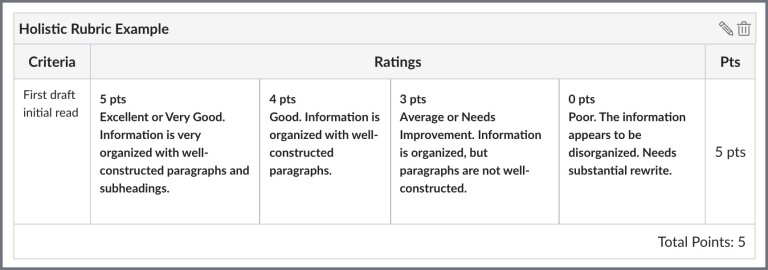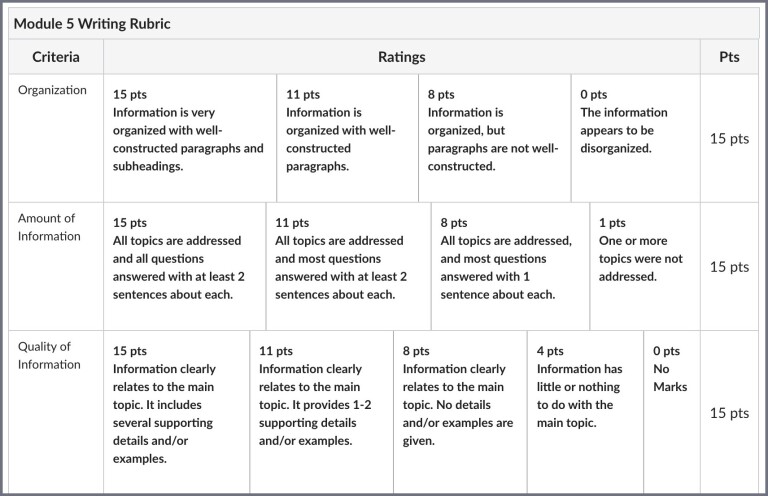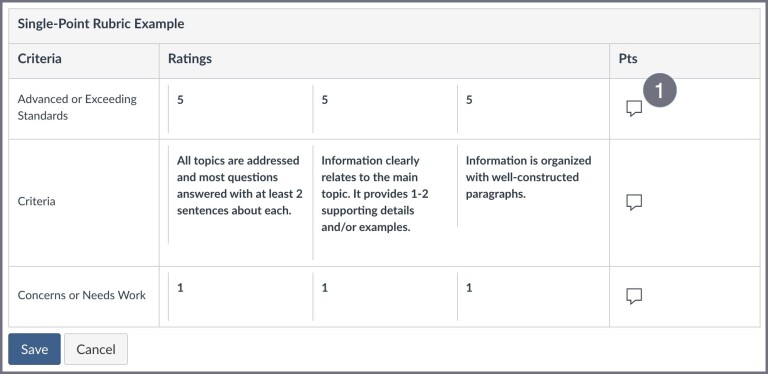Rubrics provide students with insight into their performance and mastery of learning outcomes, providing clarity on how grades are assigned and teaching students how to tailor their work. For instructors, rubrics take the guesswork out of deciding how to grade, saving valuable time.
We recommend including three to five “non-negotiable” and equally valuable criteria, with an even number of performance levels in the rating scale, since odd-numbered rating scales tend to result in catch-all middle categories.
We also recommend the rating scale is equal across each performance level (the difference between getting a 4 and a 3 should be the same as the difference between 3 and 2, and 2 and 1, and so forth).
Finally, we suggest that faculty avoid relying on rubric “crutches” like numbers (e.g., word counts, number of resources) and vague, subjective language (e.g., good, excellent, mostly, somewhat) to determine a grade (Miller, 2012). Ill-defined terms—“somewhat present,” “mostly successful,” and so on—leave room for uncertainty about how to improve. By contrast, using consistent language and syntax can ensure consistency.
How you should make a rubric
1. Holistic: A generalized method of evaluation, holistic rubrics grade a whole deliverable on the basis of one measurement scale. According to Cult of Pedagogy (who we follow for the advantages and disadvantages of each rubric below), the advantage of a holistic rubric is speed, while the disadvantage is lack of targeted feedback.

2. Analytic: Divided into component skills, analytic rubrics allow instructors to apply a measurement scale to a number of component criteria. The advantage of an analytic rubric is a clear picture of why students receive their specific grade, while the disadvantage is the amount of time and consideration required to make the rubric.

3. Single-Point: Similar to an analytic rubric, single-point rubrics break down assignments into component criteria, but criteria are evaluated with a single point value instead of a scale of measurement. While the single-point rubric is easier for students to read and follow, it requires more individualized feedback effort from the instructor.

Beyond grading: How (else) you should use a rubric
When utilizing rubrics, consider implementing rubrics for peer and self-reflection, as rubrics have benefits over and above time-saving. Among other things, rubrics have been found to be an educational tool to promote self-efficacy, a student's belief that they have the capabilities to complete the task at hand (Andrade et al., 2009). Rubrics can also help students plan their work, since “rubric[s] can increase knowledge of the criteria for writing” (Andrade et al., 2009, p. 287; Greenberg, 2015).
When used as a tool for peer evaluation, rubrics can improve students’ grades. In the short term, students can transfer the knowledge they acquire from using a rubric to assess another student’s work to their own papers. In the longer term, when students are allowed to collaborate on the criteria for assessment, they gain a deeper understanding of what makes good work (Greenberg, 2015; Reddy & Andrade, 2010).
Far beyond grading, consider using rubrics for the following:
- explaining an assignment to students, helping them to understand the criteria by which they will be assessed
- giving students a chance to use a rubric to assess other students
- enabling students to execute better re-writes after giving feedback with a rubric
- encouraging students to collaborate on assignment criteria and determine what constitutes quality work
References
Andrade, H. L., Wang, X., Du, Y., & Akawi, R. L. (2009). Rubric-referenced self-assessment and self-efficacy for writing. The Journal of Educational Research, 102(4), 287–302. https://doi.org/10.3200/JOER.102.4.287-302
Gonzalez, J. (2014, May 1). Know your terms: Holistic, analytic, and single-point rubrics. Cult of Pedagogy.
Greenberg, K. P. (2015). Rubric use in formative assessment: A detailed behavioral rubric helps students improve their scientific writing skills. Teaching of Psychology, 42(3), 211–217. https://doi.org/10.1177/0098628315587618
Miller, A. (2012, January 18). Tame the beast: Tips for designing and using rubrics. Edutopia.
Reddy, Y. M., & Andrade, H. (2010). A review of rubric use in higher education. Assessment & Evaluation in Higher Education, 35(4), 435–448.

